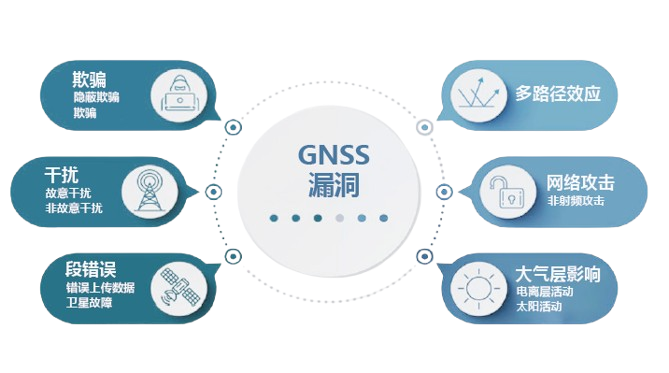R&D and technical capabilities
core technology
A-PNT |
Anti-jamming and anti-spoofing technology
GNSS signal interference and spoofing have always been the biggest challenges faced by the industry. Compass Bontec's newest anti-jamming high-precision receiver, which is fully independent and controllable, can effectively suppress suppression interference such as broadband, narrowband, multi-tone, single-tone, frequency sweep, pulse, continuous wave and multi-system combination, and at the same time, realize multi-system joint positioning and timing. It supports carrier phase and pseudo-range differential positioning at BDS-B3 and BDS-B1 frequency points under anti-jamming, and can realize high-precision positioning under broadband interference scenarios at BDS-B3 frequency points. It is suitable for high dynamic and high precision positioning and timing applications in complex electromagnetic environment and strong interference environment. By integrating high-precision atomic clocks, GNSS satellite timing and trusted time scale, Beidou Bontec's newly launched Virtual Primary Reference Clock (vPRTC) builds a network timing architecture with high security, redundancy and anti-spoofing capabilities, thus meeting the increasing demand for accurate and reliable time synchronization of today's critical infrastructures.


ePRTC | Enhanced Primary Reference Clock Technology
ePRTC (Enhanced Primary Reference Clock) technology has significant performance enhancements and advantages over traditional PRTC. By deeply integrating a high-precision cesium atomic clock with multi-constellation GNSS receivers, ePRTC can stably maintain nanosecond time accuracy during normal operation and strictly meet the requirements of ITU-T G.8272.1 standard. When the GNSS signal is interrupted for a long period of time (e.g., two weeks) or subject to electromagnetic interference or spoofing attacks, the high stability of the cesium atomic clocks ensures that the system can still maintain excellent time accuracy during the ultra-long holdover period, so as to enable the system to maintain uninterrupted and accurate timing in critical infrastructures.
MSSS |
Full support for multiple synchronization protocols and international standards
Our system is compatible with multiple types of synchronization and timing protocols such as IEEE 1588 PTP, NTP, SyncE, IRIG-B and IEEEC37.118, 8021.AS, etc., and strictly follows the international standards such as ITU-TG.8272, G.8262 and IEEE 1588. With multi-protocol and multi-standard support, it can be seamlessly integrated into telecom networks, data centers, smart grids, broadcasting and national defense systems to achieve high-precision time synchronization at microsecond to nanosecond level. Facing the demand of 5G, ultra-low latency and large-scale access, the system pre-meets the requirements of future communication and distributed application scenarios. High throughput, multi-layer redundancy and PTP multi-profile support ensure excellent performance in complex and diverse network environments, providing accurate and reliable time and frequency support for critical infrastructure and advanced applications.
MRF | Multiple Reference Source Fusion
Digital Phase Locked Loop (DPLL) technology integrates Rubidium clocks with ultra-high stability crystals to provide both short- and medium-term stability and low noise. Rubidium atomic clocks have high frequency stability on medium- to long-term time scales, ensuring that the system maintains an accurate reference frequency over a long period of time. The ultra-high stability crystal, with its short-term ultra-low phase noise performance and fast locking characteristics, enables the system to maintain excellent frequency purity in transient and short time scales, realizing second stability ≤ 3E-13 and 1000 seconds ≤ 4E-14.
MHA |
Advantage of localized multi-hardware and system adaptation
Through modularized architecture and multi-layer adaptation abstraction, we effectively isolate the underlying hardware and operating system differences to ensure that the same clock solution can be quickly ported and deployed on multiple processor architectures, embedded systems and server platforms. At the same time, with unified protocol interfaces and configurable middleware, we maintain consistent performance across different operating systems (e.g., Kirin, Linux, Windows, and virtualized platforms). Through continuous integration and automated testing, we accelerate the cross-platform verification and optimization process, so that our products are always highly reliable and scalable. This series of technical advantages enable us to quickly respond to the market and customers' diversified application scenarios and ecological environment needs, and significantly enhance the flexibility and competitiveness of clock products in the deployment of domestic multi-hardware and domestic multi-operating system.
MSSS |
Full support for multiple synchronization protocols and international standards
Our system is compatible with multiple types of synchronization and timing protocols such as IEEE 1588 PTP, NTP, SyncE, IRIG-B and IEEEC37.118, 8021.AS, etc., and strictly follows the international standards such as ITU-TG.8272, G.8262 and IEEE 1588. With multi-protocol and multi-standard support, it can be seamlessly integrated into telecom networks, data centers, smart grids, broadcasting and national defense systems to achieve high-precision time synchronization at microsecond to nanosecond level. Facing the demand of 5G, ultra-low latency and large-scale access, the system pre-meets the requirements of future communication and distributed application scenarios. High throughput, multi-layer redundancy and PTP multi-profile support ensure excellent performance in complex and diverse network environments, providing accurate and reliable time and frequency support for critical infrastructure and advanced applications.
MRF | Multiple Reference Source Fusion
Digital Phase Locked Loop (DPLL) technology integrates Rubidium clocks with ultra-high stability crystals to provide both short- and medium-term stability and low noise. Rubidium atomic clocks have high frequency stability on medium- to long-term time scales, ensuring that the system maintains an accurate reference frequency over a long period of time. The ultra-high stability crystal, with its short-term ultra-low phase noise performance and fast locking characteristics, enables the system to maintain excellent frequency purity in transient and short time scales, realizing second stability ≤ 3E-13 and 1000 seconds ≤ 4E-14.
MHA |
Advantage of localized multi-hardware and system adaptation
Through modularized architecture and multi-layer adaptation abstraction, we effectively isolate the underlying hardware and operating system differences to ensure that the same clock solution can be quickly ported and deployed on multiple processor architectures, embedded systems and server platforms. At the same time, with unified protocol interfaces and configurable middleware, we maintain consistent performance across different operating systems (e.g., Kirin, Linux, Windows, and virtualized platforms). Through continuous integration and automated testing, we accelerate the cross-platform verification and optimization process, so that our products are always highly reliable and scalable. This series of technical advantages enable us to quickly respond to the market and customers' diversified application scenarios and ecological environment needs, and significantly enhance the flexibility and competitiveness of clock products in the deployment of domestic multi-hardware and domestic multi-operating system.
RCMSS |
Advantages of rapid customization of modular solutions
Through modular architecture design, the oscillator, synthesizer, distributor, redundant power supply and multiple reference sources are freely combined and hot-swappable, so that the system can be flexibly expanded and upgraded according to the actual needs. Multiple redundant reference sources and automatic failover mechanisms ensure that a continuous, stable frequency and time reference can be provided in the event of any single point of failure.
ULPN-ESCT |
Ultra-low phase noise and superior stability compatible technology
Digital Phase Locked Loop (DPLL) technology integrates Rubidium clocks with ultra-high stability crystals to provide both short- and medium-term stability and low noise. Rubidium atomic clocks have high frequency stability on medium- to long-term time scales, ensuring that the system maintains an accurate reference frequency over a long period of time. Ultra-high stability crystals, with their short-term ultra-low phase noise performance and fast locking characteristics, enable the system to maintain an accurate reference frequency during transients and short time scales. transient and short time scale always maintains excellent frequency purity, realizing second stability ≤ 3E-13, 1000 seconds ≤ 4E-14.
SyncprobeTM | Synchronized Probe Technology
SyncprobeTM is a monitoring and assurance tool for time synchronization networks that provides accurate analysis and continuous performance control of time-frequency signals under multi-source reference conditions. By capturing and comparing various input signals such as SyncE, BITS, PPS, GNSS and CLK, the system calculates timing error (TE), instantaneous error (TIE), maximum time interval error (MTIE), and PTP related indexes in real time, and presents the results in the form of visualization. When the synchronization performance deviates from the standard or reaches the preset threshold, SyncprobeTM can alert the operation and maintenance personnel to intervene in a timely manner through SNMP alerts and automatic alarms. The system generates daily performance reports and trend analysis for long-term quality tracking and optimization. In PTP networks, SyncprobeTM monitors key parameters such as message delay, packet loss rate and delay asymmetry, and supports statistical metrics evaluation based on the G.8261.1 standard. With these features, SyncprobeTM ensures that network synchronization in critical scenarios such as 5G, data centers, smart grids, and national defense communications always maintains high accuracy and reliability, enabling smarter, more controllable, and efficient time and frequency operation and maintenance.
RCMSS |
Advantages of rapid customization of modular solutions
Through modular architecture design, the oscillator, synthesizer, distributor, redundant power supply and multiple reference sources are freely combined and hot-swappable, so that the system can be flexibly expanded and upgraded according to the actual needs. Multiple redundant reference sources and automatic failover mechanisms ensure that a continuous, stable frequency and time reference can be provided in the event of any single point of failure.
ULPN-ESCT |
Ultra-low phase noise and superior stability compatible technology
Digital Phase Locked Loop (DPLL) technology integrates Rubidium clocks with ultra-high stability crystals to provide both short- and medium-term stability and low noise. Rubidium atomic clocks have high frequency stability on medium- to long-term time scales, ensuring that the system maintains an accurate reference frequency over a long period of time. Ultra-high stability crystals, with their short-term ultra-low phase noise performance and fast locking characteristics, enable the system to maintain an accurate reference frequency during transients and short time scales. transient and short time scale always maintains excellent frequency purity, realizing second stability ≤ 3E-13, 1000 seconds ≤ 4E-14.
SyncprobeTM | Synchronized Probe Technology
SyncprobeTM is a monitoring and assurance tool for time synchronization networks that provides accurate analysis and continuous performance control of time-frequency signals under multi-source reference conditions. By capturing and comparing various input signals such as SyncE, BITS, PPS, GNSS and CLK, the system calculates timing error (TE), instantaneous error (TIE), maximum time interval error (MTIE), and PTP related indexes in real time, and presents the results in the form of visualization. When the synchronization performance deviates from the standard or reaches the preset threshold, SyncprobeTM can alert the operation and maintenance personnel to intervene in a timely manner through SNMP alerts and automatic alarms. The system generates daily performance reports and trend analysis for long-term quality tracking and optimization. In PTP networks, SyncprobeTM monitors key parameters such as message delay, packet loss rate and delay asymmetry, and supports statistical metrics evaluation based on the G.8261.1 standard. With these features, SyncprobeTM ensures that network synchronization in critical scenarios such as 5G, data centers, smart grids, and national defense communications always maintains high accuracy and reliability, enabling smarter, more controllable, and efficient time and frequency operation and maintenance.